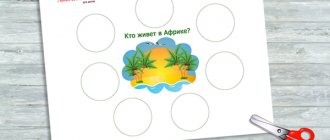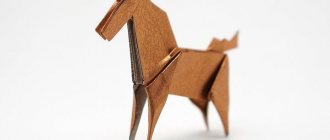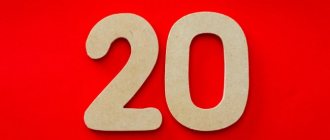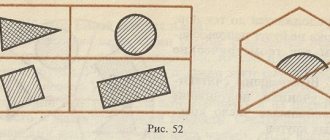How to complete the task
- Print out the proposed tasks for children on A4 or A5 sheets.
- There is a red dot on each sheet - the graphic dictation will begin from this place.
- Explain to your child that 1 step is one cell. 2 steps - 2 cells, and so on. Each step occurs from one corner of the cell to the next in a given direction.
- It is necessary to clarify the concepts of “right”, “left”, “up”, “down” and “diagonally”.
- You can perform graphic dictation directly under dictation, or independently using the arrows at the top of each sheet.
- Great concentration and attentiveness are required, since even 1 mistake will lead to the drawing not working out. When used in classes at home with mother, mother's supervision is recommended.
Options for drawing by cells
Options for drawing by cells for children 6-7 years old can be divided into three groups:
- Drawing according to the proposed scheme, where the student must independently reproduce a similar drawing in his notebook.
- Drawing dictated by a parent or teacher. This task is performed by ear, and the adult indicates the direction of action - the number of cells up, down, right, left.
- Tasks without a drawn figure, but only with indication of the symbols by which the child himself draws. This is one of the most difficult options that is offered to older children. With this version of graphic dictation, the number of cells is indicated by a number, and the direction of movement is indicated by an arrow.
Drawing lessons on the topic “Tank” for older preschoolers in preschool educational institutions
Continue the drawing by cells
In this type of task, children are presented with a symmetrical repeating pattern, which must be continued, for example, to the end of the line. The pattern can be of different levels of complexity, both the most elementary and more difficult. You can print such tasks on sheets of paper, or purchase special printed notebooks and put them in a math corner in the garden. Parents at home can come up with a pattern themselves by drawing it in a regular notebook, which the children will have to repeat.
An example of a simple checkered pattern
Symmetrical (mirror) drawing in cells
Mirror drawing in cells invites the child to complete part of the drawing, half of which has already been completed. But not just complete the drawing, but exactly as shown. The finished part can be located on the left or right, or maybe on top or bottom. The second option is more difficult. The child must strictly observe symmetry and draw the number of cells that was initially specified. These tasks are more difficult than others, but they perfectly develop abstract and logical thinking, perseverance and accuracy.
Print easy graphic dictations
To download the picture you like, click on it to enlarge. After that, save the image to your device. This way you can print out graphic dictations for free for personal use.
Graphic dictations by cells free download
Graphic dictations on a gray field in PDF format
Graphic dictations on a yellow field in PDF format
Print oral graphic dictations with answers
They try to make tasks for oral dictation a little simpler than those tasks that are done “from sight”, since they require more preparation and concentration. There are no diagonal lines in them. They are also provided with a picture answer to quickly show children an image of the correct solution.
If you find it difficult to unravel abstract images, here is a hint: the following are encrypted: sailboat, dragon, snowflake, bear, lion, car, chair, ladybug, hippopotamus, ship, octopus, hare, snowman, boat, turtle.
Methods for conducting graphic dictations
You can conduct a graphic dictation in different ways.
- For those guys who are just starting to practice them, the simplest method is suitable - under the dictation of an adult. In this case, the teacher or parent dictates to the child how many cells and in what direction he needs to move.
An example of such a dictation is the “Dog” dictation. The task is completed by the child under the dictation of instructions from adults.
- The second way is to offer the child a piece of paper on which instructions for completing the task are written and a starting point is set from which the child needs to move. The child himself looks at the number of cells and the direction of movement.
As an example, look at the graphic dictation
- "Car"
- "Horse"
- "Ship"
- The third way is to draw by symmetry. In such dictations, the child is given a sheet on which half of the drawing is depicted and a line of symmetry is drawn. The child completes the drawing by symmetrically counting the required number of cells.
Here an adult draws half of the Christmas tree and draws a line of symmetry. Children are asked to complete the second half symmetrically.
- The fourth method is suitable for older children.
Here the child is offered a sheet with a sample graphic dictation. The child must draw the same picture on his sheet as in the sample, independently counting the required number of cells and determining the direction in which he needs to move. Such dictations can be not only in the form of drawing lines along the cells, but also with completely coloring the required number of cells with colored pencils. As a result, the baby gets a colorful, beautiful picture in his notebook.
A simple option could be the “Elephant” drawing. Offer your child only the finished image and set a point from which he needs to move.
In the same way, you can invite the child to draw a “Snake”, which is also easy to follow (the instructions should be removed, offering only the finished version) or “Squirrel”.
More difficult tasks are
And the following schemes will be even more difficult to implement:
Dictations for independent work
These tasks, where the dictation field and the “path” with arrows are located next to each other, are convenient to use for independent work.
Explain to your child that movement along the arrows begins with a dot. The signs should be read from left to right horizontally .
Reverse task
If your child confidently and happily completes tasks in the cells under dictation and independently, offer him the task in reverse . You give a sample drawing, and the child encodes the movements of the pencil from the starting point: 2 up, 3 to the left, 1 down, 2 to the right, etc...
You don’t need to know how to write - the direction can be indicated with arrows. But knowing the numbers is a must!
To get started, you can use the pictures below, and then go even further: offer not only to encrypt the picture yourself, but first draw it on checkered paper!
Card index of graphic dictations for senior preschool age
Olga Serebryakova
Card index of graphic dictations for senior preschool age
Graphic dictations seem like fun to children, but at the same time they cause difficulties for many. And overcoming these difficulties, the child learns, remembers concepts such as right and left, top and bottom, and consolidates these concepts in practice. Just a couple of these graphic dictations a week in just a couple of months will allow the preschooler to no longer get confused about the names, but to navigate accurately. Dictation consists of drawing in cells, respectively, under the dictation of a parent or teacher. Therefore, another important skill is developed in a child by dictation , and in particular graphic dictation - it teaches listening and hearing.
In my methodological development, I offer you several options for graphic dictation in cells for classes with preschool . Some of them involve only movement up, down, right, left within 10, without diagonal movement, the subsequent ones are more complex, with angular movements.
During classes, the child’s attitude and the friendly attitude of the adult are very important. Remember that activities for a child are a game, and please do not ruin the child’s positive impression of this game. Help your child, make sure he doesn’t make mistakes. The result of the work should always satisfy the child, so that he wants to draw in the cells again and again. The adult’s task is to help the child in a playful way master the skills necessary for good study. Therefore, never scold him. If something doesn’t work out for him, just explain how to do it correctly. I wish you success!
CARD INDEX OF GRAPHIC DICTTINGS.
Card No. 1 .
Instructions:
From a given point, move 2 cells to the right, 2 down, 2 to the left, 2 up.
What shape did you draw?
Color the square yellow.
Card No. 2
Instructions:
From a given point, move 4 cells to the right, 2 down, 4 to the left, 2 up.
What shape did you draw?
Color it green
Card No. 3
Instructions:
From a given point, move 1 square to the right, 1 down, 1 to the right, 1 down, 2 to the left, 2 up.
Guess what the figure looks like?
Color the figure green.
Card No. 4
Instructions:
From a given point, move 3 cells to the right, 2 down, 1 to the left, 1 down, 2 to the left, 3 up.
Guess what the figure looks like?
Color the figure orange (yellow)
color.
Card No. 5
Instructions:
From a given point, move 1 square to the right, 2 down, 1 to the right, 1 down, 2 to the left, 3 up.
Guess what the figure looks like?
Color the figure blue.
Card No. 6
Instructions:
From a given point, move 1 square to the right, 1 down, 1 to the right, 3 down, 3 to the left, 3 up, 1 to the right, 1 up.
Guess what the figure looks like?
Card No. 7
Instructions:
From a given point, move 2 cells to the right, 2 down, 1 right, 2 down, 4 left, 2 up, 1 right, 2 up.
Guess what the figure looks like?
Color the figure yellow.
Card No. 8
Instructions:
From a given point, move 3 cells to the right, 1 down, 1 left, 2 down, 1 left, 2 up, 1 left, 1 up.
Guess what the figure looks like?
Color the figure red.
Card No. 9
Instructions:
From a given point, move 5 cells to the right, 2 down, 2 left, 1 down, 1 left, 1 up, 2 left, 2 up.
Guess what the figure looks like?
Color the figure green.
Card number 10
Instructions:
From a given point, move 4 cells to the right, 2 down, 1 left, 1 up, 2 left, 1 down, 1 left, 2 up.
Guess what the figure looks like?
Color the figure red.
Card No. 11
Instructions:
from a given point, draw: 2 cells to the right, 2 down, 2 to the left, 2 up, 2 to the left, 2 down, 2 to the right.
What shapes did you get? How many? Color the 1st square blue, the 2nd square green.
Color the figure brown.
Card number 12
Instructions:
From a given point, move 1 square to the right, 1 down, 2 to the right, 1 up, 1 to the right, 3 down, 1 to the left, 1 up, 2 to the left, 1 down, 1 to the left, 3 up.
Guess what the figure looks like?
Color the figure with any color of your choice.
Card number 13
Instructions:
from a given point, move 4 cells to the right, 1 down, 1 left, 2 down, 1 right, 1 down, 4 left, 1 up, 1 right, 2 up, 1 left, 1 up.
Guess what the figure looks like?
Color the figure purple (blue)
color.
Card number 14
Instructions:
From a given point, move 1 square to the right, 1 down, 2 to the right, 1 up, 1 to the right, 4 down, 1 to the left, 1 down, 2 to the left, 1 up, 1 to the left, 4 up.
Guess what the figure looks like?
Color the figure orange or red.
Card number 15
Instructions:
From a given point, move 1 square to the right, 1 down, 1 right, 1 down, 1 left, 1 down, 1 left, 1 up, 1 left, 1 up, 1 right, 1 up.
Guess what the figure looks like?
Color the figure light green (green)
color.
Card number 16
Instructions:
From a given point, move 1 square to the right, 1 down, 1 right, 1 up, 1 right, 4 down, 1 left, 2 up, 2 left, 2 up.
Guess what the figure looks like?
Color the figure blue.
Card number 17
Instructions:
From a given point, move 2 cells to the right, 2 down, 1 right, 1 down, 2 left, 2 up, 1 left, 1 up.
Guess what the figure looks like?
Color the figure yellow.
Card No. 18
Instructions:
From a given point, move 1 square to the right, 1 down, 1 right, 1 down, 1 right, 3 down, 5 left, 3 up, 1 right, 1 up, 1 right, 1 up.
Guess what the figure looks like?
Color the figure brown.
Card number 19
Instructions:
From a given point, move 1 square to the right, 2 down, 1 right, 2 up, 1 right, 2 down, 1 right, 2 up, 1 right, 3 down, 5 left, 3 up.
Guess what the figure looks like?
Color the figure red.
Card number 20
Instructions:
from a given point, move 2 cells to the right, 1 up, 1 right, 1 down, 2 right, 2 down, 1 left, 1 up, 3 left, 1 down, 1 left, 2 up.
Guess what the figure looks like?
Color the figure pink (red)
color.
Card number 21
Instructions:
from a given point, move 1 square to the right, 1 up, 1 right, 1 down, 1 right, 1 up, 1 right, 1 down, 1 right, 2 down, 1 left, 1 down, 1 left, 1 up, 1 left, 1 down, 1 left, 1 up, 1 left, 2 up.
Guess what the figure looks like?
Color the figure green.
Card number 22
Instructions:
from a given point, swipe 1 right, 1 down, 1 right, 1 down, 1 right, 1 down, 1 left, 1 down, 1 left, 1 down, 1 left, 5 up.
Guess what the figure looks like?
Color the figure with your favorite color.
Card number 23
Instructions:
from a given point, move 1 square to the right, 1 up, 1 right, 1 down, 1 right, 1 down, 1 left, 2 down, 1 right, 1 down, 3 left, 1 up, 1 right, 2 up, 1 left, 1 up.
Guess what the figure looks like?
Color the figure purple.
Card number 24
Instructions:
From a given point, move 1 square to the right, 2 down, 1 right, 1 up, 1 right, 2 down, 5 left, 2 up, 1 right, 1 down, 1 right, 2 up.
Guess what the figure looks like?
Color the figure blue (blue)
color.
Card number 25
Instructions:
from a given point, swipe: 1 right, 1 down, 1 right, 2 up, 1 right, 2 down, 1 right, 1 up, 1 right, 1 down, 1 right, 1 down, 7 left, 1 up, 1 right, 1 up.
Guess what the figure looks like?
Color the figure blue.
Card number 26
Instructions:
from a given point, move 1 square to the right, 2 down, 2 right, 2 down, 1 left, 1 up, 1 left, 1 down, 1 left, 1 up, 1 left, 1 down, 1 left, 2 up, 2 right, 2 up.
Guess what the figure looks like?
Color the figure green.
Card number 27
Instructions:
from a given point, move 1 square to the right, 2 down, 1 right, 1 up, 1 right, 3 down, 1 left, 1 up, 1 left, 2 down, 1 left, 2 up, 1 left, 1 down, 1 left, 3 up, 1 right, 1 down, 1 right, 2 up.
Guess what the figure looks like?
Color the figure blue.
Card number 28
Instructions:
from a given point, swipe 1 right, 1 down, 1 right, 1 down, 2 right, 2 up, 1 right, 4 down, 1 left, 3 left, 1 down, 1 left, 4 up.
Guess what the figure looks like?
Color the figure pink or red.
Card number 29
Instructions:
from a given point, move 2 cells to the right, 1 down, 1 right, 1 down, 1 right, 1 down, 1 left, 1 down, 1 left, 1 down, 2 left, 1 up, 1 left, 1 up, 1 left, 1 up, 1 right, 1 up, 1 right, 1 up.
Guess what the figure looks like?
Color the figure yellow.
Card number 30
Instructions:
from a given point, move 1 square to the right, 1 down, 3 to the right, 1 up, 1 to the right, 1 down, 1 to the right, 1 down, 1 to the left, 1 down, 1 to the left, 1 up, 3 to the left, 1 down, 1 to the left, 1 up, 1 left, 1 up, 1 right, 1 up. Guess what the figure looks like?
Color the figure red.
Card number 31
Instructions:
From a given point, move 2 cells to the right, 1 down, 2 right, 1 up, 2 right, 1 down, 2 left, 1 down, 2 left, 1 up, 2 left, 1 up.
Guess what the figure looks like?
Color each rectangle with a different color.
Card number 32
Instructions:
From a given point, move 1 square to the right, 4 down, 1 left, 1 up, 4 right, 1 down, 1 left, 4 up, 1 right, 1 down, 4 left, 1 up.
Think about what the figure looks like.
Color the large square green, the small ones yellow.
Card number 33
Instructions:
from a given point, move 2 cells to the right, 2 down, 1 right, 1 up, 1 right, 3 down, 1 left, 1 up, 1 left, 1 down, 1 left, 3 up, 1 left, 1 up.
Guess what the figure looks like?
Color the figure grey, black, yellow or brown.
Card number 34
Instructions:
From a given point, move 2 cells to the right, 4 down, 3 right, 1 down, 1 left, 2 down, 1 left, 1 up, 1 left, 1 down, 1 left, 6 up, 1 left, 1 up.
Guess what the figure looks like?
Color the figure yellow or brown.
Card number 35
Instructions:
from a given point, move 1 square to the right, 3 down, 3 right, 1 down, 1 left, 1 down, 1 left, 1 down, 1 left, 1 down, 1 left, 1 up, 1 left, 1 up, 1 left, 1 up, 1 left, 1 up, 3 right, 3 up.
Guess what the figure looks like?
Color the figure pink.
Card number 36
Instructions:
from a given point, move 1 square to the right, 3 down, 1 right, 1 down, 1 right, 1 down, 1 left, 1 down, 1 left,
1 down, 1 left, 1 up, 1 left, 1 up, 1 left, 1 up, 1 right, 1 up, 1 right, 3 up.
Guess what the figure looks like?
Color the figure orange or yellow.
Card number 37
Instructions:
from a given point, move 1 square to the right, 1 down, 1 right, 1 down, 2 right, 1 down, 3 left, 3 down, 1 right, 1 up, 1 right, 2 down, 3 left, 4 up, 3 left, 1 up , 2 right, 1 up, 1 right, 1 up.
Guess what the figure looks like?
Color the figure the way you like.
Card number 38
Instructions:
From a given point, move 3 cells to the right, 1 up, 4 right, 1 down, 1 left, 1 down, 1 left, 1 down, 4 left, 1 up, 1 left, 1 up.
Guess what the figure looks like?
Color the figure brown.
Card number 39
Instructions:
from a given point, move 3 cells to the right, 1 up, 4 right, 1 down, 1 right, 2 down, 1 left, 1 down, 1 left, 1 up, 3 left, 1 down, 1 left, 1 up, 2 left, 2 up .
Guess what the figure looks like?
Does your family have a car? Paint the figurine the same color as your family's car.
If there is no car, then paint the figure with your favorite color.
Card number 40
Instructions: from a given point, move 2 cells to the right, 1 up, 1 right, 1 up, 2 right, 1 down, 1 left, 1 down, 2 right, 1 up, 1 right, 2 down, 3 left, 1 down, 1 right, 1 down, 2 left, 1 up, 1 left, 1 up, 2 left, 1 up.
Guess what the figure looks like?
Color the figure gray or blue.
Card number 41
Instructions:
from a given point, move 3 cells to the right, 1 down, 5 right, 1 down, 1 right, 1 down, 1 left, 1 down, 5 left, 1 down, 3 left, 1 up, 1 right, 1 up, 1 left, 1 up, 1 right, 1 up, 1 left, 1 up.
Guess what the figure looks like?
Color the figure gray.
Card No. 42 Instructions:
from a given point, move 2 cells to the right, 7 down, 2 right, 1 down, 6 left, 1 up, 2 right, 4 up, 2 left, 1 up, 1 right, 1 up, 1 right, 1 up.
Guess what the figure looks like?
Color the figure yellow.
If it’s difficult for a child...
If it is difficult for a child to complete tasks on cells with arrows, perhaps you have simply not yet worked out the meaning of the arrows, the concepts of “right, left, top, bottom.” Start with simple arrow exercises like these to get the vocabulary right.
Drawing by cells for children 5-7 years old
Drawing by cells is an effective tool for developing children's attentiveness. You can practice this format of activity from the age of five to six, gradually complicating the tasks. Most often, such graphic dictations are tasks in mathematics of the preparatory group “by cells” - one of the favorite activities of children. Thanks to it, children develop fine motor skills and spatial imagination. And all this is done in a playful way. Children, without noticing it themselves, learn something new and actively develop.
Graphic dictations
Such exercises are performed not only in kindergarten, but also in elementary school. This helps with the learning process and gives you some rest, especially when learning new, difficult topics.
Graphic dictations for school preparation
If the presented tasks did not seem enough to you, do not waste time searching for pictures in Yandex or Google.
Printing materials on various sites are often of poor quality, and there are errors in the dictation text, which completely kills the child’s desire to study further.
Here: print out assignments to prepare for school.
Ready-made manuals with graphic dictations are inexpensive and interesting . Here are examples.
Dictations from the book 5+ “Funny Cells. Graphic dictations. To prepare for school."
A very interesting set of tasks in Elena Uleva’s manual “Super developmental tasks for first graders. Graphic dictations for first graders"
Scans of tasks from the series “Waco. On the way to school. Graphic dictations"
Spreads of the notebook “Graphic dictations. Attention training. 1 class":
From the manual “Graphic dictations. From simple to the most complex. Guidelines for activities with children aged 5-7 years:
Symmetrical (mirror) drawing in cells
Graphic drawings in cells can be completed without an additional task - you need to rely not on numbers and arrows, but on the image itself.
In this case, presented below, the child sees a half-drawn house, which is made schematically. The cells will tell you in which direction you need to move, how many cells to complete in one direction or another.
Such activities are interesting for older children who already understand what specularity and symmetry are. That is, if the drawing is folded in half, you will get ½ of the entire image, which means you need to mirror the lines that are already on the sheet.
The drawings are different, and there is no point in indicating a diagram of the direction of hand movement. The child understands at what distance the square is removed, how to repeat it in mirror image, so that the end result is a symmetrical “analog” of what is in front of his eyes.
Graphic drawings should develop children's thinking and help them better master the school curriculum. It’s not for nothing that similar games can be found on the Internet and enjoyed by the whole family. If drawing in the squares does not work, perhaps the child will develop other interests - artistic interpretation, an attraction to music, or an interest in other sports/activities.
The main thing is that the school minimum does not cause a negative reaction, then mathematics will be a joy not only in the 1st grade, but also in the 10th grade.







